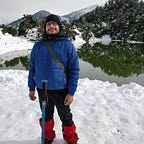Life in the Himalayas: Experiencing village lifestyle in the hills
Ever wondered how people live in villages, what they do for a living, how they keep themselves fit and entertained. Everyone has experienced this in his/her lifetime. And some of you might have been lucky enough to visit your native places once or twice a year. As described by the father of the nation, Mahatma Gandhi, “The soul of India lives in its villages”, the Indian villages have a great role to play in our independence movement and thereafter in the economy of India. Without them, a nation cannot grow to its optimum.
This is one such experience of living the village life in the hills of Uttarakhand, especially in the Kumaon region of the state. This time, I embarked on a breathtaking journey with my close friend who is a native of this region.
Day-1: Bus journey to Ramnagar and further journey to Paisiya
We started our journey by taking an overnight bus to Ramnagar. The 242km route covers places like Ghaziabad, Hapur, Garh Mukteshwar, Gajraula, Moradabad, and Kashipur. Ramnagar is a small town on the foothills of the Kumaon hill region. Since the bus reached Ramnagar early morning, we took another bus towards Paisiya village. The bus was relatively smaller and was crowded with people. The bus took us through the Jim Corbett Forest area where we were lucky to spot some elephants with some breathtaking views of the adjacent hills. The bus covered a route of 64km in 2 hours due to the uphill section.
Paisiya is a small village in the Almora district of Uttarakhand. The village has some decent shops for eatery and other necessary goods. At one of the tea and breakfast shops, we had our breakfast and then we waited for a taxi for our onward journey to our destination “Dadimi”.
Elephant on its way to the jungle
Kumaon hills during the rainy season
Signboard of Paisiya village for buses and taxis
With my close friend at Paisiya village
Day-2: Reaching Dadimi and trekking uphill in the village
We boarded the taxi and after half an hour’s drive, we reached our destination. My friend told me that his paternal uncle is the head (sarpanch/pradhan) of this village. So we won’t be having any problems here. As soon as we entered the courtyard, his uncle along with his wife and children were there to welcome us. The house was a typical pahadi style one made with stones and mud. The ground floor usually has either kitchen or a cowshed for keeping cows. The upper floor has one living room and a bedroom. Further on the upper floor, one has a space equivalent to two rooms.
Pahadi house with the ground, first and second floor
Courtyard in front of the house
The living room
Garden beside the house
Cattle grazing the fodder
After a heavy lunch and a good 3-hour sleep, we woke up and went out to see the village. The people there were welcoming. We were offered fresh fruits straight from their gardens. We went uphill to their village temple to see the view of the hills. The night was colder than we thought and the silence of the road and the village premises was an experience which one doesn’t get in cities. We had the traditional pahadi cuisine for dinner consisting of Meat, Rice Mandua ki Roti (Finger Millet), and Kandali ki Subzi (Wild Green Nettle). Kandali or Nettle is a wild plant found in the hills which has a needle-like surface on its leaf. When touched, it releases a chemical that causes an itching sensation.
Pomegranate tree with its fruits
Uphill trekking towards the village temple
Clouds over the village
Evening view from the courtyard
Kandali leaf or Nettle leaf (See the needle-like surface on the leaf)
Day-3: Early morning rain and back to Delhi
We woke up early morning only to experience rain and its magic. The lush green hills were a sight to behold upon. The greenery around us rejuvenated the atmosphere and we quickly captured it through our lenses. We had a quick breakfast and bid adieu to my friend’s family for the warm hospitality. We took a direct taxi from the village itself to Ramnagar Railway Station, thanks to my friend’s uncle, who arranged it in no time. The 70km journey was covered in just 2 hours and we boarded our train on time.
Scenic view after a fresh spell of rain
Some important facts:
- One can travel to other places from Ramnagar like Jim Corbett National Park, Ranikhet, Almora, and Nanital. Buses and Taxis are available from the Bus Stand.
- Alternatively, one can take a train to Ramnagar which usually runs from Old Delhi Junction.
- Do carry light warm clothes and enough cash since the more you go up, the fewer ATMs are available for dispensing cash.
- People in the villages either depend on agriculture or selling daily needs, grocery or tea, and breakfast shops for their living. The women of the village generally are involved with the household work along with working in the fields and fetching water from a nearby source. But the scenario has changed due to the installation of solar energy and water taps in village houses. Apart from handling daily chores, the women are now running shops and helping the family in earning a decent amount for a living.
